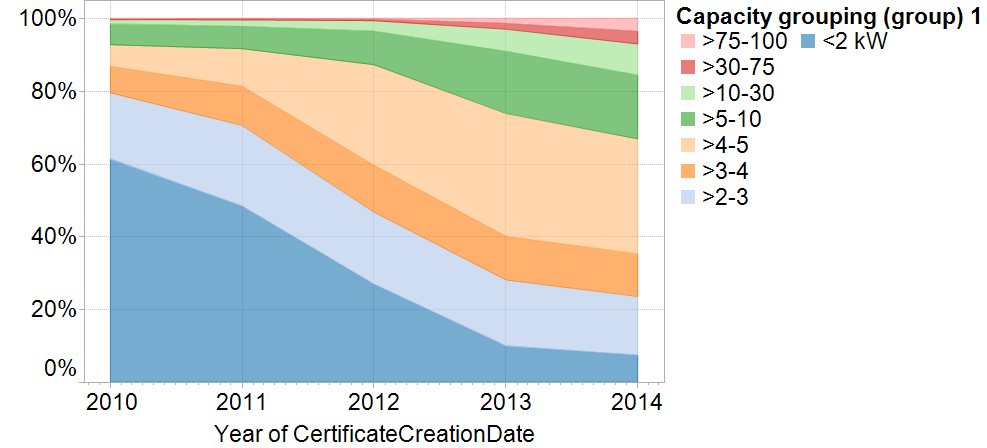Bigger solar for the home is better: here's why
I've periodically puzzled over the fact that the size of solar systems installed in Australia has steadily increased over the years. But I've now realised that it makes complete financial sense – many households will be several hundred dollars better off per year choosing a 5 kilowatt system instead of the pre-2010 standard of a 1.5kW system.
The reason for my earlier puzzlement was that systems have significantly increased in size while at the same time the financial reward for electricity exported to the grid has plummeted with the demise of government mandated feed-in tariffs.
Just last week solar market analyst Warwick Johnston of SunWiz released the chart below, providing a superb illustration of how the previously dominant sub 2kW system (typically 1.5kW) has almost completely died out. The household market is now dominated by systems of 3kW or more. Of course we're also now seeing the emergence of a market for much larger solar systems that are typically installed on business premises too.
Figure: The changing share of different sized solar systems in the Australian market

Source: SunWiz (2015)
This demise of the sub 2kW system seems odd. The biggest bang for your buck from investing in solar comes from using it to meet your own power consumption, avoiding a charge of something like 25 cents to even 50 cents per kilowatt-hour. Power generated excess to a household's own consumption on the other hand now receives just 6 cents to maybe 10 cents (power retailer Click Energy offers this in some circumstances), while it used to receive as much as 45 to 66 cents under government feed-in tariffs which have been progressively downgraded and abolished in the last few years.
Households typically find that even a small 2kW system will still produce, on average, around 30% more electricity than the household will consume during solar generating daylight hours. Meanwhile a 5kW system is roughly estimated to export around 50% to 70% of its power, according to Johnston.
So after the first one to two kilowatts, the revenue from extra solar capacity steeply declines. This has led me in the past to conclude the trend to larger systems is a product of purchase decisions based on very rough rules of thumb or emotional factors.
But once you take into account the other element of the equation – costs – going bigger starts to make complete sense.
This has now become rather obvious because of significant reductions in the price of the underlying solar panel modules. This has meant that a large and increasing proportion of the cost of the system is fixed or changes little irrespective of system size. Think of the labour time involved in travelling to the installation site, the setting up of safety equipment for working on the roof, the wiring up and installation of the inverter and then wiring it to the solar panels, the paperwork involved, and the salesperson's time. These don't change between a 1.5kW system and 5kW system.
So for a 1.5kW system a customer will face a price somewhere close to $3000 or $2000 per kilowatt. Better deals are available ($1750 has been advertised) but suppliers don't fight terribly hard to win these small-sized installations.
By comparison some larger suppliers are prepared to install a 5kW system for between $5000 to $6000. That's around half the price per kilowatt at $1000 to $1200 per kilowatt.
Also a narrow focus on maximising the percentage rate of return from a solar system is not the appropriate financial metric for many people.
Solar tends to bought by people in the mortgage belt and often they can finance the solar system by using the redraw facility of their home loan – this involves a cost that might lie between 5% to 6% interest per annum. For self-funded retirees (also big buyers of solar), they might fund it through withdrawing funds from their superannuation account at a similar cost once you consider tax implications (reductions in the size of your electricity bill aren't taxable income). So provided the cost of the system doesn't exhaust their redraw or their super, the key thing will be maximising the gain in cashflow they can generate from diverting this source of money into solar.
Based on a 6% interest rate and 15-year term (less than the life of the solar system) the annual payments for a 1.5kW system costing $3000 will be $260, and $520 for a 5kW system costing $6000.
In return the 1.5kW system will generate about $480 in savings on your power bill every year. Meanwhile the 5kW system, even though it generates more than three times the electricity of the smaller system, will only deliver 200% of power bill saving – $960. That's because it exports about 70% of its output at 7 cents per kWh instead of roughly 30% for the 1.5kW system.
Nonetheless the 5kW system is the better bet because the household will have an extra $440 each year ($960 minus $520) versus $220 for the 1.5kW system ($480 minus $260).
In addition to providing a higher cashflow, the bigger system also potentially provides a better ability to take advantage of future developments in the energy market. This could include things like:
– the emergence of cheap batteries;
– the reintroduction of a price on carbon;
– switching away from gas to electricity; and
– laying claim to a grid connection capacity right which might become more restricted over time.













